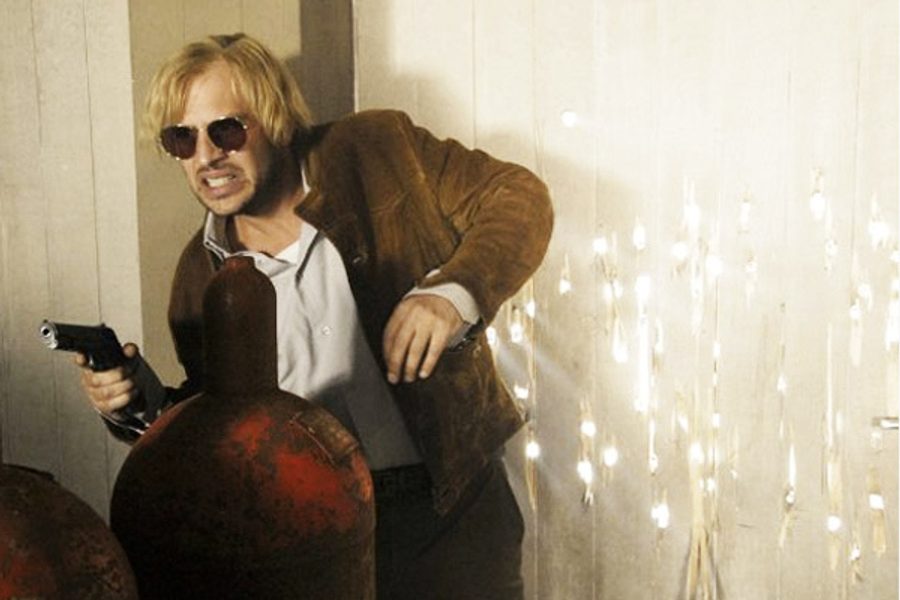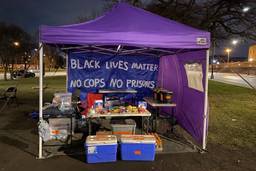Romancing the Terrorists
The Baader Meinhof Complex glamorizes a Cold War-era German terrorist group without questioning its politics and violence.
Christina Gerhardt

Wooden batons wielded by German police club students, gashing their foreheads. Water cannons explode, toppling people in their path like bowling pins. Mounted police horses charge at demonstrators. A gunshot rings out.
So begins the Oscar-nominated The Baader Meinhof Complex, which tells the history of the Red Army Faction (RAF), a German terrorist group active from 1970 to 1998.
The film – based on Stefan Aust’s book of the same title – presents the German student movements from 1967 to 1970, and the history of the RAF from its inception in 1970 to the deaths of its first generation in the Stammheim maximum-security prison in 1977. Featuring archival footage and dramatic re-enactments, The Baader Meinhof Complex blurs the distinction between documentary and fictional films, thus highlighting the role that cinema plays in shaping our understanding of history. But what type of history of left-wing extremism does the film provide?
To a large extent, the film’s fast-moving pace – prodded along by its quick cross cuts and heavy reliance on one-liners – prevents a substantive engagement with the problematic politics, domestic and international, that led to the group’s actions.
The opening sequence depicts the June 2, 1967, fatal shooting of Benno Ohnesorg, an unarmed student demonstrator, who was killed by police officer Karl Heinz Kurras. Ohnesorg was protesting the Shah of Iran’s visit to Berlin. Yet the film does not mention that the students were demonstrating the Shah’s repressive regime at home.
Already on the edge, the events of June 2, 1967, further radicalized the student movement. In an emergency meeting held that evening, future RAF member Gudrun Ensslin stated: “This fascist state means to kill us all… Violence is the only answer to violence.” The Baader Meinhof Complex, however, never questions critically the group’s stance and its use of violence.
In 1968, Ensslin (played by Johanna Wokalek), Andreas Baader (Moritz Bleibtreu) and two others set a Frankfurt department store on fire. Their goal was to “light a torch for Vietnam,” “protest against indifference to the war” and against “monopoly capitalism.” After a German court ordered the four arsonists to prison in November 1969, Baader and Ensslin fled. In 1970, Baader was pulled over by a police officer and thrown in jail.
The RAF wasn’t officially founded until 1970, when prominent journalist Ulrike Meinhof (Martina Gedeck) helped break Baader out of jail. Meinhof had become sympathetic to the student movement, particularly after witnessing the violent backlash against demonstrations and the skewed representation of them in the corporate media.
After the jail break, the group fled to a Palestine Liberation Organization (PLO) camp in Jordan. By showing how RAF members insisted the group be housed together – not separated by gender, as its Muslim hosts preferred – and how female RAF members sunbathed nude, the film provides titillation but fails to explore why the group sympathized with the Palestinians and how this sympathy intersected with Germany’s fascist past. (This intersection is key with regard to the RAF, given some of the group’s overtly anti-Semitic statements in its communiqués.) The solidarity with the Palestinians spanned from its 1970 training at this camp to the 1977 hijacking of a Lufthansa flight bound for Mogadishu, Somalia, by the Popular Front for the Liberation of Palestine to demand the release of 11 imprisoned RAF members.
After the first hour of the film, one feels bludgeoned by the plot’s rushing momentum: a heavy soundtrack plays while bullets fly or buildings explode; cut to a TV screen showing the day’s attack on the news; pan back to German Police Chief Herold (Bruno Ganz) – or RAF members – watching the footage; cut to the next attack.
It is a chronology of events lacking narrative tension or progression. Although the group’s violence increases, no discussion follows of how this relates to the politics of leftist movements.
Character development is also lacking. Meinhof leaves her husband, abandons her children and joins the RAF, only to commit suicide in prison. Yet the audience never learns her thoughts, feelings or struggles as she goes through these transitions.
Other characters in the film remain equally flat. While the film could have shed light on the inner dynamics of the group, the personalities and motivations of its members, or even of its adversaries, it leaves instead a hollow string of actions.
What frustrates most about the two and a half-hour Baader Meinhof Complex is that, in seeking to present all events related to the RAF from 1967 to 1977, it rarely slows down to allow the viewer room to reflect.
Had the film instead explored with focus and depth any aspect of the era and the group, it could have been edifying: the legacy of the fascist era in Germany, the failures of representative democracy for leftists, the impact of international anti-imperialist struggles, the tensions between the group and other leftists, or the tensions internal to the group. Indeed, the RAF’s history offers insights to a legacy of terrorism that remains a daily feature of life and politics.
Yet, rather than engaging substantively any of the risks involved or the historical and political contexts, the film depicts the RAF in a glamorous light, as though terrorism is sexy and not tactically fraught. It is a view that, much like the RAF itself, is deeply shortsighted.





